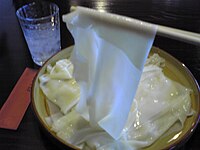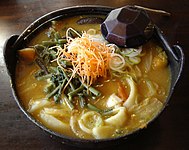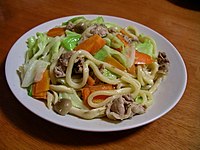food.wikisort.org - Dish
Udon (うどん or 饂飩) is a thick noodle made from wheat flour, used in Japanese cuisine. It is a comfort food for many Japanese people. There are a variety of ways it is prepared and served. Its simplest form is in a hot soup as kake udon with a mild broth called kakejiru made from dashi, soy sauce, and mirin. It is usually topped with thinly chopped scallions. Other common toppings include prawn tempura, kakiage (mixed tempura fritter), abura-age (sweet, deep-fried tofu pouches), kamaboko (sliced fish cake), and shichimi spice added to taste.
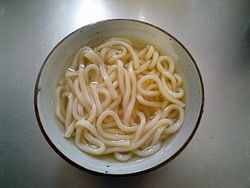 Kake udon; udon noodles in hot broth | |
| Type | Noodles |
|---|---|
| Place of origin | Japan |
| Serving temperature | Hot or cold |
| Main ingredients | Wheat flour |
Standard broth differs by region. Dark (koikuchi) soy sauce is added in eastern Japan, while light (usukuchi) soy sauce is added in the west. Instant noodles are often sold in two (or more) versions accordingly.[1]
More unusual variants include stir-fried yaki udon and curry udon made with Japanese curry. It is often used in "shabu shabu" or Japanese hot pot.
Origin
This section does not cite any sources. (January 2020) |

There are many stories explaining the origin of udon.
One story says that in AD 1241, Enni, a Rinzai monk, introduced flour milling technology from Song China to Japan. Floured crops were then made into noodles such as udon, soba, and pancakes in Japan which were eaten by locals. Milling techniques were spread around the country.
Another story states that during the Nara period, a Japanese envoy to Tang Dynasty China was introduced to 14 different kinds of food. One of them was called sakubei (索餅), which was listed as muginawa (牟義縄) in Shinsen Jikyō (新撰字鏡), a dictionary which was published in the Heian Era. The muginawa is believed to be an origin for many kinds of Japanese noodles. However, the muginawa in Shinsen Jikyō was made with wheat and rice flour.
Another story for udon claims that the original name of the noodle was konton, which was made with wheat flour and sweet fillings.[2] Yet another story says that a Buddhist priest called Kūkai introduced udon noodles to Shikoku during the Heian Era.[citation needed] Kūkai, the Buddhist priest, traveled to Tang Dynasty China around the beginning of the 9th century to study. Sanuki Province claimed to have been the first to adopt udon noodles from Kūkai. Hakata province claimed to have produced udon noodles based on Enni's recipe.[citation needed]
Dishes
Udon noodles are boiled in a pot of hot water. Depending on the type of udon, the way it is served is different as well. Udon noodles are usually served chilled in the summer and hot in the winter. In the Edo period, the thicker wheat noodle was generally called udon, and served with a hot broth called nurumugi (温麦). The chilled variety was called hiyamugi (冷麦).
Cold udon, or udon salad, is usually[citation needed] mixed with egg omelette slices, shredded chicken and fresh vegetables, such as cucumber and radish. Toppings of udon soup are chosen to reflect the seasons.[citation needed] Most toppings are added without much cooking, although deep-fried tempura is sometimes added. Many of these dishes may also be prepared with soba.
Hot
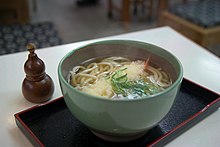


- Chikara udon: ("power udon"): topped with toasted mochi rice cakes.
- Goboten udon: with deep-fried shredded burdock root
- Haikara udon: ("modern udon"): see tanuki udon. From ハイカラ
- Kake udon (in the Kantō region) or su udon (in Kansai): hot udon in broth topped with thinly sliced green onions, and perhaps a slice of kamaboko.
- Kamaage udon: served in a communal hot-pot with hot water, and accompanied by a hot dipping sauce of dashi sukiyaki.
- Karē nanban or karē udon ("curry udon"): modern udon served in a spicy curry-flavoured broth, which may also include meat or vegetables. The term nanban is a reference to the Nanban trade which had influenced Japanese culture for a century before being banned in 1639 by the Edo Shogunate.[3] Biei, Hokkaido is famous for a unique curry udon.[citation needed]
- Kitsune udon: ("fox udon"): topped with aburaage (sweet, deep-fried tofu pouches). The dish is called "fox" because of its association with aburaage.[4] Originated in Osaka. Kitsune udon is often mistaken for Tanuki udon.
- Maruten udon: topped with maruten, deep-fried large fish cake
- Nabeyaki udon: a sort of udon hot-pot, with seafood and vegetables cooked in a nabe, or metal pot. The most common ingredients are tempura shrimp with mushrooms and an egg cracked on top.
- Oboro udon: dashi broth with kombu flakes.
- Oyako udon: chicken and egg, with sliced onion in a sweetened dashi soup over udon. It has a sweet savory flavor.
- Su udon: see kake udon
- Sutamina udon: ("stamina udon"): udon with various hearty ingredients, usually including meat, a raw egg, and vegetables.
- Tanuki udon: (in the Kantō region)[4] or Haikara udon (in Kansai):[4] topped with tempura batter pieces. Tanuki udon is often mistaken for kitsune udon.
- Tempura udon: topped with tempura, especially prawn, or kakiage, a type of mixed tempura fritter.
- Tsukimi udon: ("moon-viewing udon"): topped with raw egg, which poaches in the hot soup.
- Wakame udon: topped with wakame, a dark green seaweed.
- Yaki udon: stir-fried udon in soy-based sauce, prepared in a similar manner to yakisoba. Originated in Kitakyushu, Fukuoka Prefecture. Note that while yaki udon is made with udon, yakisoba is made with steamed Chinese-style ramen, not buckwheat soba.
Cold

- Bukkake udon: cold udon served with thick dashi broth.[5]
- Hadaka udon (裸うどん, "naked udon"): cold udon served on its own.
- Kijōyu udon: served in a cold soup of raw (unpasteurized) soy sauce and sudachi (a type of citrus) juice, sometimes with a bit of grated daikon radish.
- Zaru udon: chilled udon noodles topped with shredded nori and served on a zaru (笊/ざる, a sieve-like bamboo tray). Accompanied by a chilled dipping sauce, usually a strong mixture of dashi, mirin, and soy sauce. Eaten with wasabi or grated ginger.
Regional varieties
Japan
There are wide variations in both thickness and shape for udon noodles.
- Dango-jiru (団子汁): similar to the Hohtoh, from Ōita Prefecture. Nominally a "dumpling soup", it resembles very thick, flat udon.
- Gōsetsu udon (豪雪うどん): a slightly translucent, chewy type from Kutchan, Hokkaido. Literally "heavy snow udon", made from the starch of potatoes. The texture is different from normal udon which is made from flour. At the foot of Mount Yōtei, Hokkaido, the biggest producing area of potatoes, "potato starch udon" was eaten as a home food for farmers from long ago. The ratio of potato starch and wheat flour was improved to make it delicious even after a long time. The origin of the name "heavy snow udon" is the foot of Mount Yōtei, a heavy snowfall area, and the appearance of the noodles which is slightly translucent like snow.[6]
- Hakata udon (博多うどん): a thick and soft type from the Fukuoka.
- Himokawa (ひもかわ): an extreme flat and wide type from Kiryū, Gunma.
- Hōtō (rarely 餺飥, commonly ほうとう): a type of miso soup with a flat and wide type udon and vegetables, particularly kabocha. One of the significant differences between usual udon and Hōtō udon is salt. When Hōtō udon is made, salt is not added to the noodle dough. from Yamanashi Prefecture.
- Inaniwa udon (稲庭うどん): a thin type from Akita Prefecture.
- Ise udon (伊勢うどん): a soft type, usually eaten with sweet soy sauce, from Ise, Mie.
- In Kansai region, a soft and medium thickness type is popular.

- Kishimen (棊子麺, or more commonly きし麺): a flat type from Nagoya.
- Mimi udon (耳うどん, literally "ear udon"): a lucky preserved food in Kuzu, Tochigi. It looks similar to ears.
- Miso-nikomi udon: a local dish of Nagoya, a hard udon simmered in red miso soup. The soup generally contains chicken, a floating cracked raw egg that is stirred in by the eater, kamaboko, vegetables and tubers. The noodles are extremely firm in order to stand up to the prolonged simmering in the soup; additionally, the noodles do not contain salt, so as to avoid over-salting from the salt in the miso.
- Saitama Prefecture has several varieties of udon.
- Kazo udon (加須うどん): produced in Kazo, Saitama, a place of active wheat production. Its very orthodox hand-kneading process characterizes Kazo udon noodles.
- Fukaya Nibōtō (深谷煮ぼうとう): a type of hotoh from Fukaya, Saitama. Boiled noodles using plenty of Fukaya green onions characterize Fuyaya Niboto udon.
- Konosu kawahaba udon (こうのす川幅うどん): originated of Kōnosu, Saitama in 2009. it is characterized by its width that is as wide as eight centimeters.
- Niiza ninjin udon (新座にんじんうどん): originated of Niiza, Saitama in 2002. The noodles are kneaded with carrot and are characterized by their vivid orange color.
- Sanuki udon (讃岐うどん): a thick and rather stiff type from Kagawa Prefecture.
- Sara udon (皿うどん): a specialty of Nagasaki Prefecture. Literally "plate udon," consisting of thinner udon that are deep fried and served with any of a number of toppings.
Korea
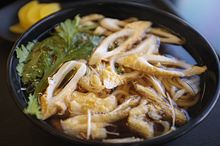
In Korea, authentic Japanese udon dishes are served in numerous Japanese restaurants, while the Korean-style udon noodle soups are served in bunsikjip (snack bars) and pojangmacha (street stalls). Both types are called udong (우동), which is the transliteration of the Japanese word udon (うどん).[7] In Korea, the word udong refers to noodle dishes (typically noodle soup), while the noodles themselves are called udong-myeon (우동면; "udong noodles") and considered a type of garak-guksu (가락국수; "thick noodles").[7] Common ingredients for udong noodle soup include crowndaisy greens and eomuk (fish cakes), neither of which are very common in Japanese udon dishes.
Palau
There is a dish called udong in Palau, originated from the former Japanese administration.[8] The broth is soy sauce–based like Japanese udon. However, as there were many immigrants from Okinawa, it uses less broth like Okinawa soba.[citation needed] Most notably, the noodle is that of spaghetti,[9] as it is easier to acquire there.
Languages of the neighboring Federated States of Micronesia also have similar loanwords from Japanese udon; Chuukese: wutong,[10]: 74 Pohnpeian: udong,[10]: 77 Kosraean: utong,[10]: 87 and Yapese: qudoong.[11]
Philippines
Cebuano: odong or udong of Davao Region and Visayas is inspired by the Japanese udon,[12][13] although they share no resemblance in modern times. Odong are wheat based yellow thick Chinese noodles (pancit),[14] similar to Okinawa soba.[15] A typical odong bowl is prepared with canned sardine and tomato sauce.[16] Other dishes such as layering with greens are also popular.[13] During the early 1900s, there was a large community of Japanese laborers in Davao,[17] half of them Okinawans.[18] In this period, the Japanese manufactured odong.[17]
Tourism

Kagawa prefecture is well known throughout Japan for its sanuki udon (讃岐うどん). It is promoted to other regions of Japan through themed mascots, souvenirs and movies.[19]
Gallery
See also
- Thick wheat noodles:
- Japanese noodles:
- Hiyamugi
- Soba
- Sōmen
- Okinawa soba
References
- 14 types of instant udon (in Japanese)
- Davidson, Alan (2014-08-21). The Oxford Companion to Food. OUP Oxford. ISBN 978-0-19-104072-6.
- Itoh, Makiko (2015-05-15). "Nanban dishes are fit for a barbarian". The Japan Times. Retrieved 2019-01-16.
- Itoh, Makiko (2018-11-17). "A comforting udon noodle recipe for the winter season". The Japan Times. Retrieved 2021-01-27.
- Gritzer, Daniel. "Make a splash with bukkake udon (Japanese cold noodles with broth)". Serious Eats. Retrieved 2017-01-27.
- "豪雪うどん | うどん ミュージアム 【うどん 博物館】". Udon Museum (in Japanese). 7 July 2013. Retrieved 25 April 2018.
- "udong" 우동. Standard Korean Language Dictionary. National Institute of Korean Language. Retrieved 15 March 2017.
- Imamura, Keisuke (2017). "The Changes in the Use of Japanese Loanwords in Palauan". Journal of the College of Liberal Arts and Sciences Tokyo Medical and Dental University (in Japanese). Japan. 47: 17, 22. doi:10.11480/kyoyobukiyo.47.0_17.
(rough translation) Chapter 5.6 Foods: ... うどん udong ... is used by almost all informants.
- "Kaigai ikunara kōdenēto – Parao" 海外行くならこーでねーと! – パラオ [(TV show) What sightseeing organizers recommend – Palau (aired on November 24th, 2012)]. TV Tokyo (in Japanese). 2012-11-24. 裏スポット【第4位】ロックアイランドカフェ(おもしろ日本食)(Interesting places ranking number 4 – strange Japanese foods). Archived from the original on 2017-08-25. Retrieved 2021-07-12.
(rough translation) Palau udon actually uses spaghetti instead of udon
- Sanada, Shinji (1998-03-25). "Characteristics of Japanese Loanword Vocabulary in Micronesian Languages (The Remnants of Japanese in Micronesia)". Memoirs of the Faculty of Letters Osaka University. 38. hdl:11094/5777. ISSN 0472-1373.
- Jensen, John T. (2017-01-07) [1977]. "qudoong". Yapese Dictionary. Archived from the original on 2019-04-22. Retrieved 2021-07-12.
- Figueroa, Antonio V. (2016-09-11). "US, Japan linguistic legacies". Issuu. Edge Davao. p. 9. Retrieved 2021-07-12.
- "Manila craves for Davao cuisine". PIA Press Release. Philippine Information Agency. 2006-04-11. Archived from the original on 2021-07-12. Retrieved 2021-07-12.
- Tayag, Claude. "26 top Filipino iconic dishes". The Philippine Star. 4.Pansit. Archived from the original on 2013-07-24.
the most popular noodle dishes loved by the locals:...Udóng in Davao
(This website enforces periodical auto-refresh with a few-minutes interval, even when archived.) - "Honba okinawa soba no teigi" 本場沖縄そばの定義 [Definition of authentic Okinawa soba]. Okinawa Noodle Manufacturing Co-op (in Japanese). Archived from the original on 2021-06-10. Retrieved 2021-07-12. (Unlike udon, Okinawa soba contains kansui agent.)
- Ong, Kenneth Irvin (2018-10-18). "For the love of Ligo sardines". Edge Davao. Archived from the original on 2018-10-22. Retrieved 2021-07-12.
- Goodman, Grant K. (1967). "Japanese Percentage of Participation in Davao Province Industries". Davao: A Case Study in Japanese-Philippine Relations. University of Kansas, Center for East Asian Studies. p. 31. hdl:1808/1195.
60% of Odong manufacturing
- Ohno, Shun (2006-03-01). "Rethinking Okinawan Diasporas in 'Davaokuo' with Special Reference to Their Relations with Mainland Japanese and Filipino Residents of Davao, the Philippines" 「ダバオ国」の沖縄人社会再考 -本土日本人、フィリピン人との関係を中心に-. Immigration Studies (移民研究). Okinawa: Center for migration studies, University of the Ryukyus (琉球大学移民研究センター). 2. abstract (pp21–22). hdl:20.500.12000/6447. ISSN 1881-0829.
- "UDON - 作品 - Yahoo!映画". yahoo.co.jp.
- Tsuji, Shizuo (1980). Japanese Cooking: A Simple Art. Kodansha International/USA, New York. ISBN 1568363885
На других языках
- [en] Udon
[ru] Удон
Удон (яп. 饂飩, обычно записывается как うどん) — один из видов лапши из пшеничной муки, характерных для японской кухни, как и соба. Слово происходит от южнокитайского названия вонтонов.Другой контент может иметь иную лицензию. Перед использованием материалов сайта WikiSort.org внимательно изучите правила лицензирования конкретных элементов наполнения сайта.
WikiSort.org - проект по пересортировке и дополнению контента Википедии
